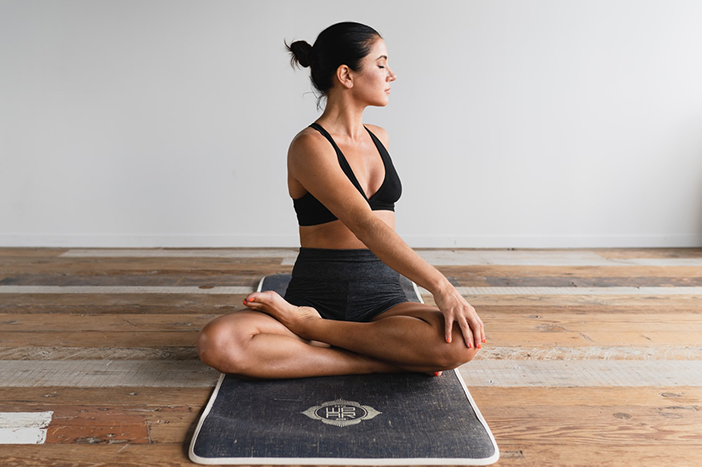 Feature Image by Dane Wetton
Feature Image by Dane Wetton
Poor posture is something of an epidemic these days. Unless you’re a yogi, a personal trainer, or just incredibly in tune with your body, there’s a good chance that you’re slumped while reading this.
While the hunched stature might be comfortable momentarily, Kate Ligler, NASM CPT and MINDBODY wellness specialist, reminds how damaging it can be in the long run. “Our body is incredibly adaptable,” she starts. “But, unfortunately, we adapt just as quickly to negative stressors, like poor posture, as we do to positive stressors, like exercise. From circulation to hormone production, poor posture affects much more than how we move as we age.”
With that in mind, keep reading to learn eight ways to improve your posture in no time.
Standing shoulder rolls
This might seem too simple to be effective, but Ligler and Poulin Health & Wellness CEO and founder Nicholas Poulin ensures that it works wonders for correcting slumping shoulders. “It works to not only reestablish length in the chest and shoulders but also strengthens the mid- and upper-back musculature,” Ligler explains. To perform the stretch, Poulin says to stand up tall and shrug your shoulders up and back, retracting your shoulder blades as you go. “Keep your shoulder blades retracted and then shrug up towards your ears and back into neutral position,” he instructs.
Child’s pose
When you have poor posture, there’s a good chance that your shoulder and chest muscles are shortened in the process. Ligler says that this position helps stretch and reestablish length to reverse the effects of perpetually hunching forward. “Starting on your hands and knees, sit your hips backward on your heels while walking your hands as far forward as possible with palms flat on the floor,” she instructs. “Let your head drop through your elbows and rest (ideally) on the floor (or use a prop for support).” To go even deeper with the stretch, press your armpits towards the floor, which she says will help further stretch your chest and shoulders.
Door frame chest stretch
If you sit for most of the day, your posture could probably use a boost. According to both Ligler and Poulin, this is just the stretch to pull your shoulders back and boost a more aligned spine.”Put both arms at a 90-degree angle on a door frame and have one leg staggered with one leg in front,” Poulin instructs. “Slowly lean into the leg going forward focusing on the chest stretch.”
Bent-knee windshield wipers
One of the many downsides of poor posture is that you can develop a sore mid- and upper-back that makes it painful to sit up straight for long periods of time. It’s a vicious cycle. Fortunately, this stretch improves mobility through your thoracic spine, which Ligler says will reduce that stiffness and stretch as far down as your low back and as high up as your neck. To reap the benefits, lie on your back and bring your knees into a tabletop position with your knees bent at 90-degrees. “Extend your arms to a ‘T’ at your sides,” she instructs. “Inhale, and with a tight core, slowly lower both bent knees to the left side of your body until the side of your left leg is fully on the floor with your right stacked on top.” While moving through this, make sure that both shoulder blades are flat on the floor.” After five to 10 seconds, re-engage your core and rotate your legs to the right side,” she adds.
Lats stretch
Your lats help support your back, which means they, too, have a role in poor posture. Poulin says to start this stretch standing tall with your back straight and hands above your head. “Gently lean to one side until you feel a mild to moderate stretch in the side of your upper back and shoulder,” he guides. “Hold for five seconds and then return to the starting position.” So long as the movement isn’t painful, he says to repeat it up to 10 times for an optimal stretch.
Shoulder internal rotation
If you’re struggling with rounded shoulders or a shoulder injury in general, it can have an adverse effect on your posture. To remedy the problem, Poulin says to grab a dumbbell weight (ask a professional trainer how much weight is safe for you) and take a seat. “Sitting in a chair, place a rolled-up towel between your elbow and your side, bending your elbow at 90-degrees to hold it in place,” he instructs, noting to gently squeeze the towel with your elbow to prevent it from falling out. “Hold the weight with your thumb pointing up. Slowly move the weight across your chest. Stop when your hand reaches your opposite arm.” From here, hold the position as long as comfortable before slowly returning to the starting position.
Shoulder external rotation
On the opposite end of the spectrum, we have an external rotation which will help to keep your shoulders from slumping forward while sitting and standing. This time, lie on your side with your injured shoulder facing up and bend your elbow to 90-degrees. Again, place a rolled-up towel between your elbow and your side with a weight in your hand. “Slowly rotate your arm outward, but keep your elbow bent to keep the towel in place,” he says. “Stop when you feel a stretch. Hold this position for 30 seconds or as directed. Slowly return to the starting position.”
A final word
No matter what stretch you’re doing, Poulin emphasizes the importance of diaphragmatic breathing. “It’s done by contracting the diaphragm, a muscle located horizontally between the thoracic cavity and abdominal cavity,” he explains. “Air enters the lungs, the chest does not rise, and the belly expands during this type of breathing.” When you breathe this way — which requires inhaling in through your nose and exhaling out through your mouth — you’re able to achieve your deepest, steadiest breath.
xx, The FabFitFun Team




